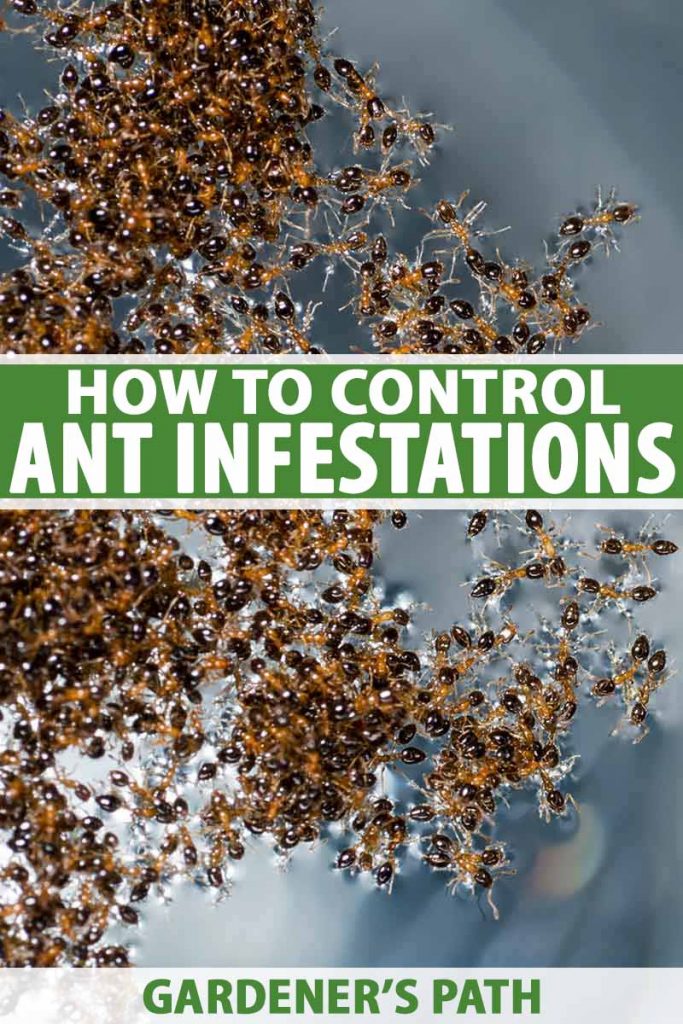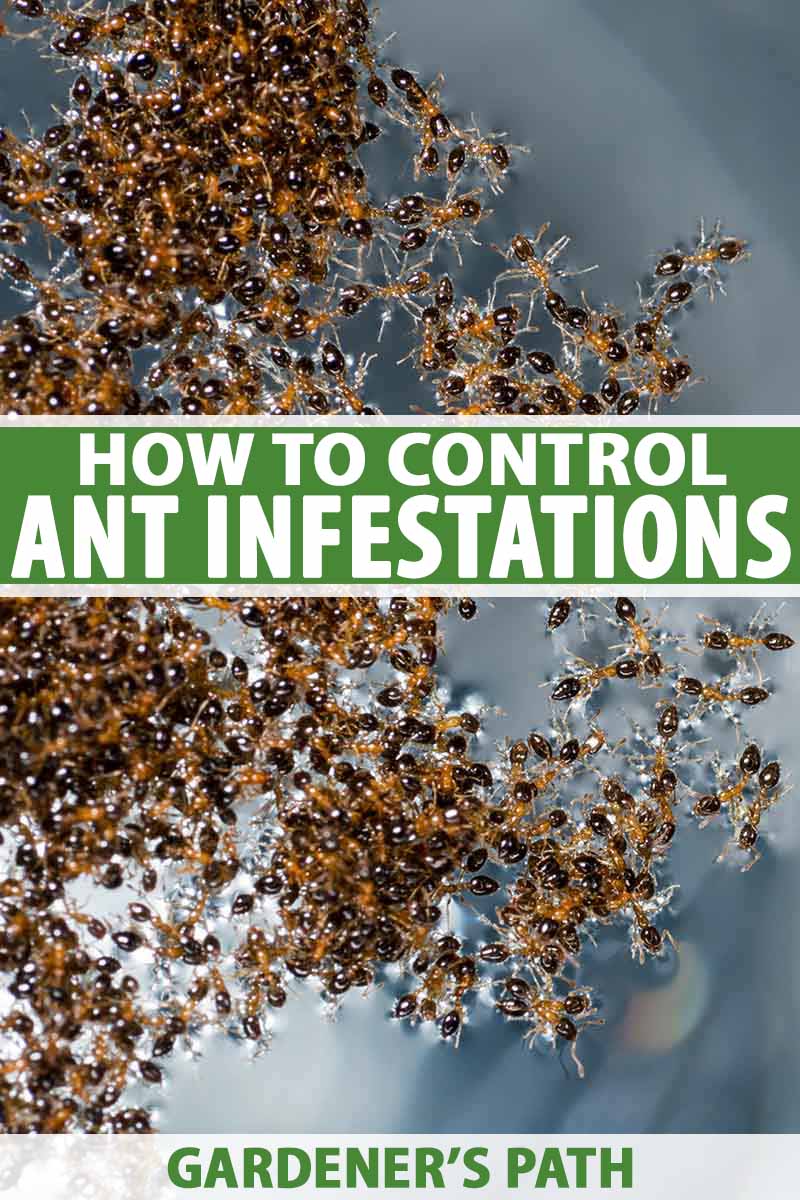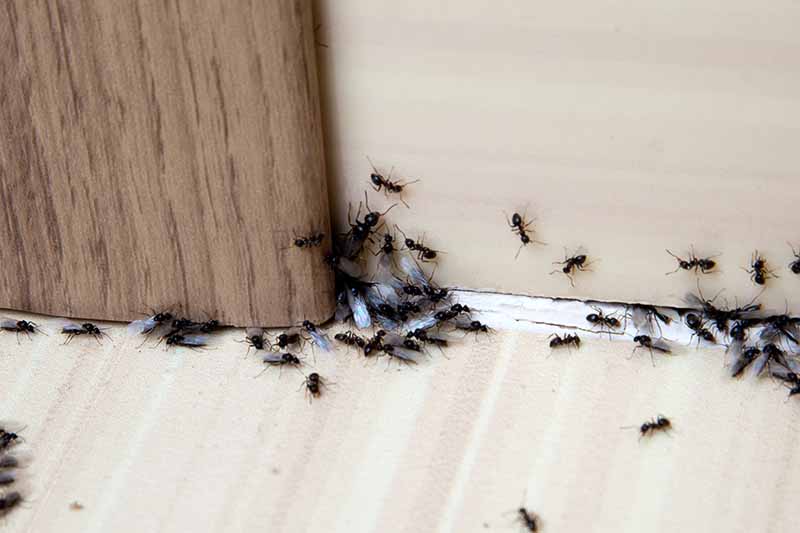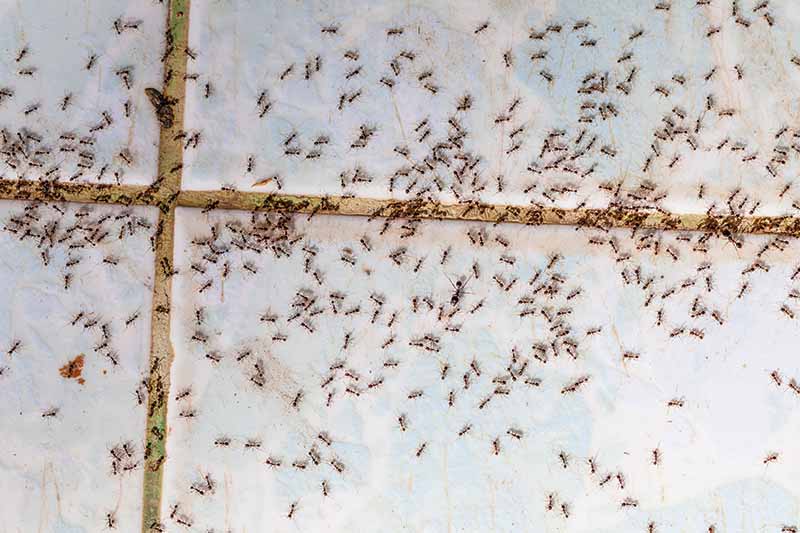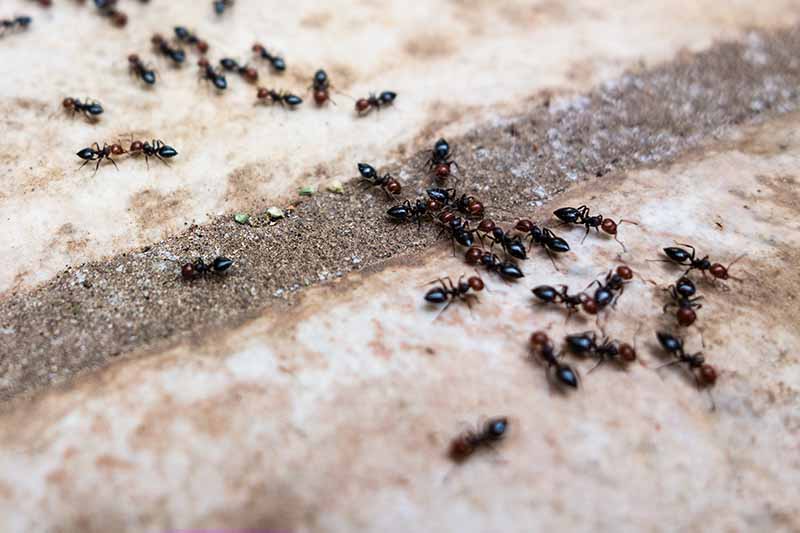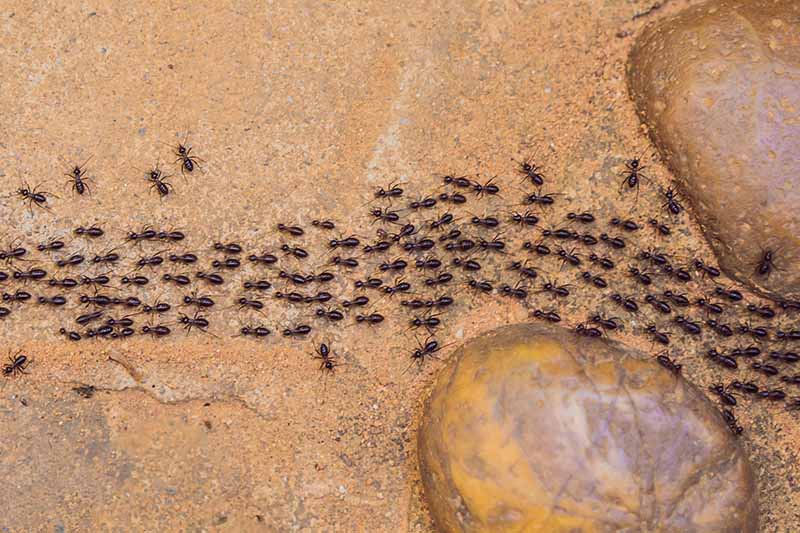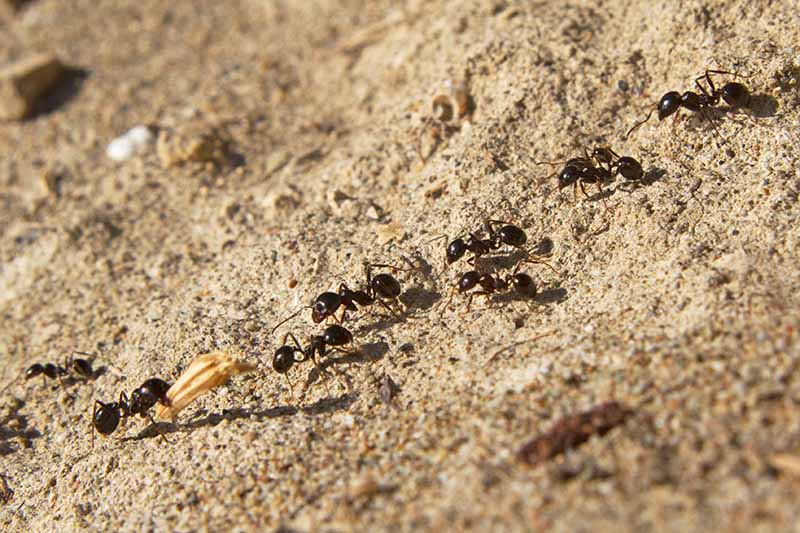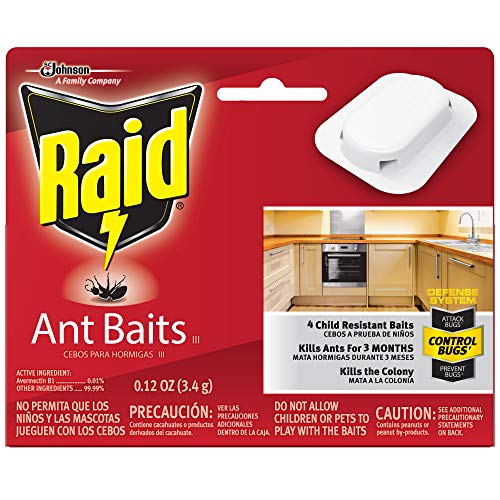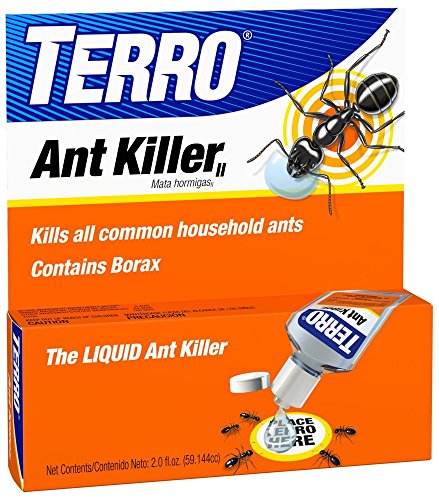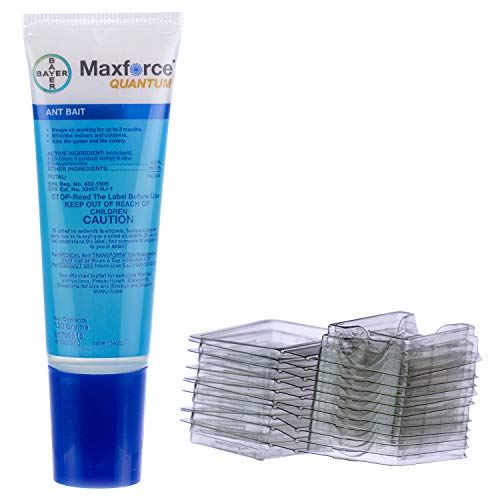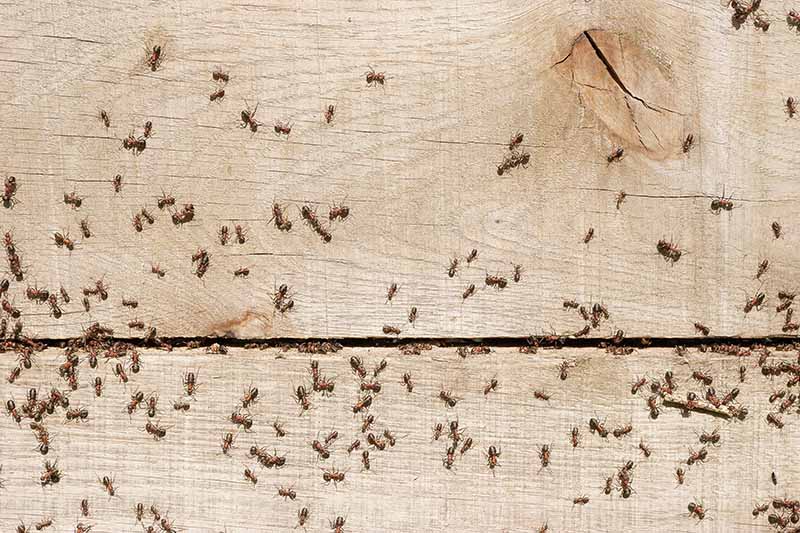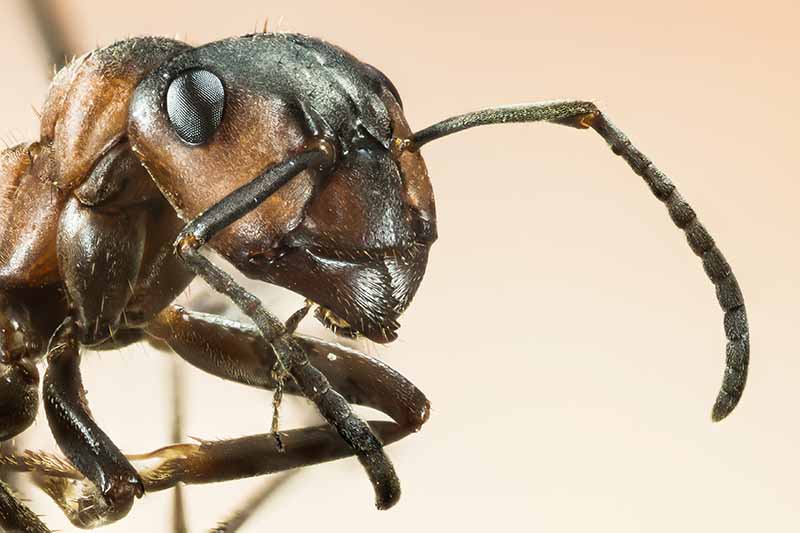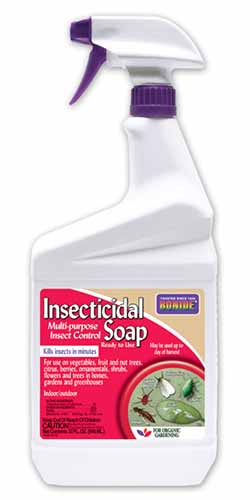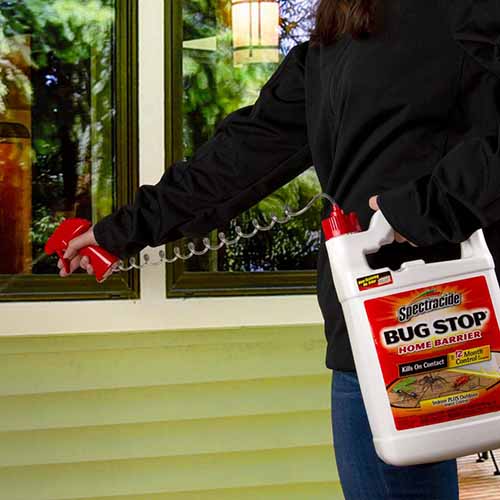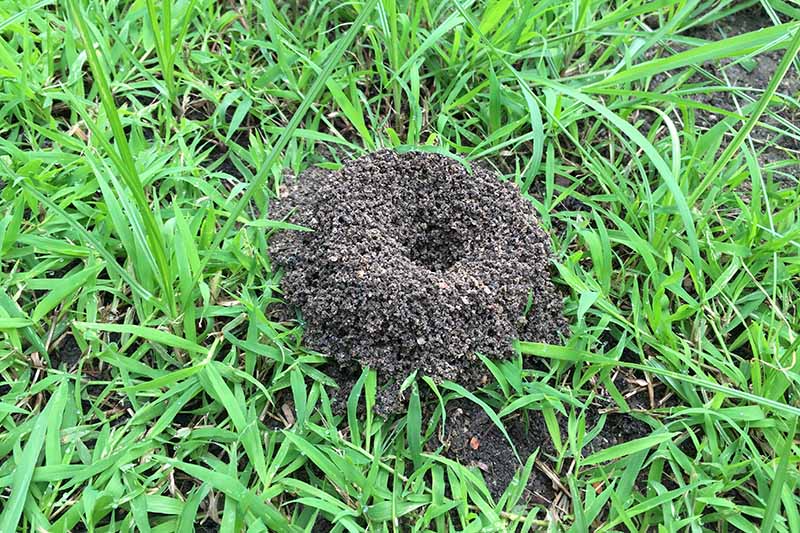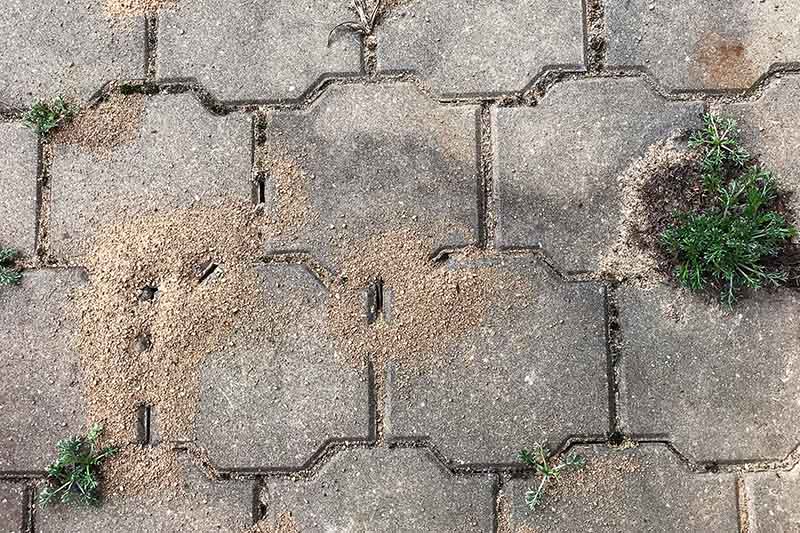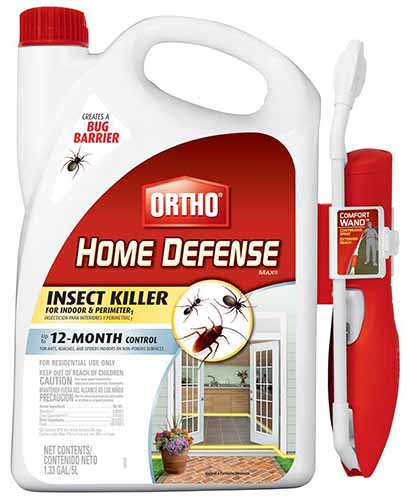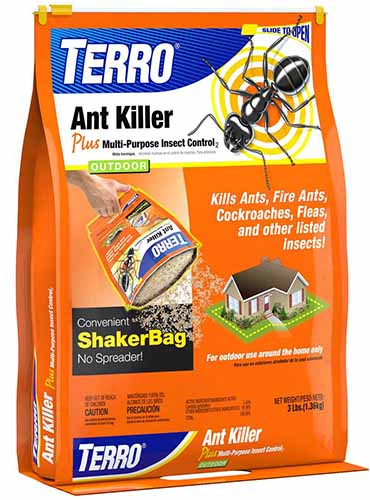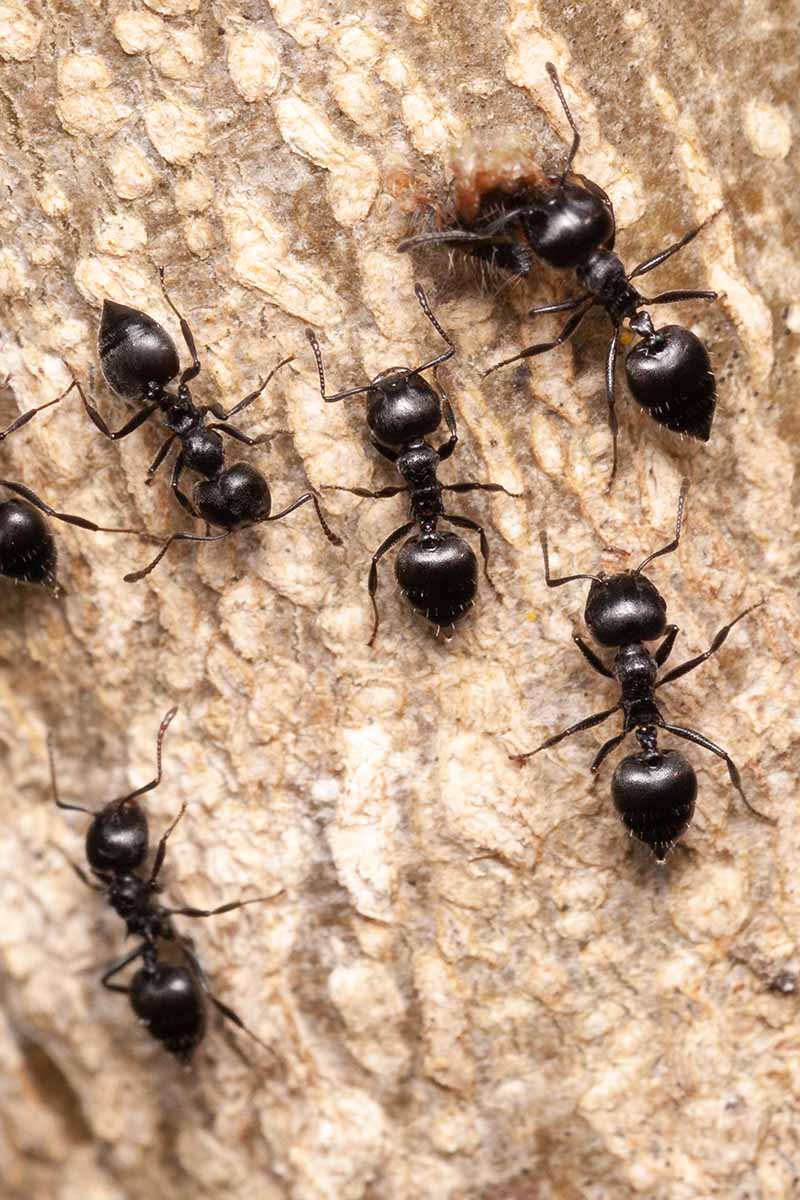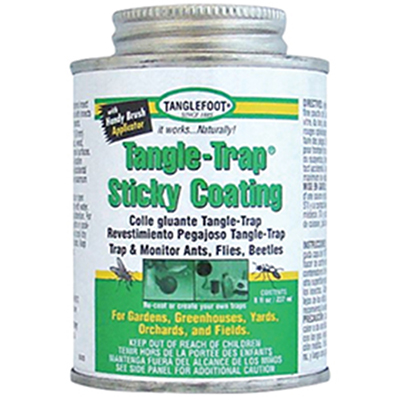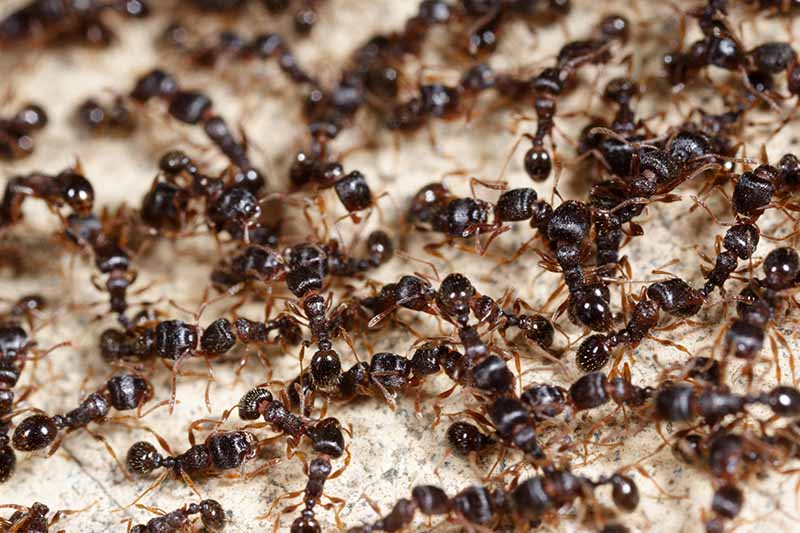However, it’s possible to combat many of these invaders yourself, without enlisting the help of a professional exterminator. We link to vendors to help you find relevant products. If you buy from one of our links, we may earn a commission.
Basic Colony Structure
Ants form colonies – some composed of millions of insects, others with as few as several dozen. The ants you normally see trailing around your kitchen are female workers. These are the individuals that collect food and bring it back to feed their queen – who is sequestered deep in the colony, laying eggs.
The queens can live as long as 15 years, depending on the species, and during their lifetime can lay thousands of eggs. At certain times of year, the colonies produce “swarmers.” These are large numbers of winged insects that emerge from the nest to mate and form new colonies. If you find a swarm inside your home, a nest is nearby.
Since swarming ants look similar to termites, this behavior can be alarming to a homeowner. Look closely – this is how to tell the difference between ants and termites:
Ants tend to have very narrow waists while termites have wider ones. The antennae of ants are bent, but on termites, they are straight. The hind wings of ants are smaller than those in front, while they are about equal in size on termites.
How to Minimize Indoor Ant Invasions
If you have a problem with ants, you will likely go to the store and buy insecticide sprays and baits just to be on the safe side.
Easy peasy, right? Not so fast! Controlling ants can be a very difficult process and requires a combination of cultural, sanitation, mechanical, and often chemical treatments. Different species respond to different types of bait. Some prefer sweets or starches, while others prefer fats or meat. Additionally, as odd as it might seem, you don’t want to kill them too quickly. The ones you see trailing around your home are the workers. Just by killing the visible workers, you do not kill the entire colony.
To do this, you want the workers to take the bait that’s laced with insecticide and bring it back to the colony, to poison the entire nest. It is imperative that you kill the queen. For as long as the queen survives, she’ll be laying eggs and producing even more ants! Knowing what species you are dealing with will help you to decide which control method is best. The best way to identify your problem species is to put a few of the insects in a baggie or vial, and take them to your local extension office. Alternatively, try and take a close up picture and email it to them. Ants invade the inside of homes and other structures for many reasons. Usually it is because they are in search of food and water. They may also be trying to avoid dry weather, hot temperatures, or flooding. Whatever the reason, you want to get rid of them as quickly as possible. There are some key steps you can take.
Eliminate Ant Trails
Ants follow invisible chemical trails made of pheromones that help them return to their colonies, and disrupting these trails can literally throw them off their scent.
These trails also lead others from the colony to the food source they’ve located in the back of your pantry, or that maple syrup spill under the table that you’d forgotten about. Not to frighten you, but these trails can be thousands of individuals long! But first you’ve got to find them. Not all ant trails are obvious, because some species tend to only move at night.
For example, if you have carpenter ants, you’ll need to track them at night with a flashlight when it’s dark, between 10pm and 2am, to find out where their nest is. If you’re lucky, it’s not in your home! Once you’ve located the trail, you have two options. Either place ant bait nearby to encourage the insects to take the bait and return to the colony and poison the queen, or just eliminate the trail itself. Though be aware if you just eliminate the trail they are likely to return if you are providing a source of food for them. You can wipe the trails down with soapy water, or treat them with a mild solution of diluted white vinegar. Other options are to vacuum them, or spray them with window cleaner.
Use Bait
Ant baits are the key insecticidal solution for most indoor and outdoor infestations.
They combine food with a slow-acting insecticide, and baits are more effective and safer than sprays. Common insecticides used in ant baits include avermectin B, boric acid, fipronil, imidacloprid, and hydramethylon. However, you want to avoid baits that kill too quickly otherwise you’ll only kill the insects that actually eat the bait and not the whole colony. This includes bait stations filled with the insecticides permethrin or cyfluthrin.
If Necessary, Bring in the Professionals
If all else fails, bring in a professional exterminator who is trained in IPM, integrated pest management.
Types of Bait
There are different kinds of bait. Some are pre-filled plastic “stations,” while others are available in a syringe or tube that’s ready for application. The advantage of the bait stations is that the insecticide is contained in a sealed plastic unit and can be placed strategically around the house. Raid Ant Bait Stations, 4-pack However, Michael F. Potter of the University of Kentucky College of Agriculture, Food, and Environment strongly recommends selecting the kind of bait that you apply from a syringe or plastic tube. One advantage of these baits is that you can apply them directly to the small crevices and cracks that the ants are using to get into your home. Some brands use various types of liquid boric acid that you can pour into refillable containers. Terro Indoor Liquid Ant Killer 2 ounces Maxforce Quantum Ant Control Liquid Bait with 10 Stations This product remains effective for up to three months. You’ll receive a bottle of the imidacloprid based bait and ten plastic bait stations.
Strategies for Using Bait
You should put the bait next to the insects’ trail. To begin with, you can expect to see an increase in the number of ants near the bait.
It is very important that you resist the urge to spray them! If you kill them, they will not be able to take the bait back to their nests, and your infestation will continue unabated. You may need to treat the area several times over a period of a few weeks to make sure that the whole colony is exterminated. Unfortunately, this process does not always go smoothly.
These insects are finicky. Even if you figure out what type of food they like, their food preferences may change during the course of the year. If the invading colony has access to highly desirable alternate food sources, they may avoid your bait altogether. You may have the best luck if you start baiting in late winter or early spring, when the ants are often just starting their infestations, and when other food sources may be scarce. You may want to test out various types of baits to see which kind works before putting your plan into action on a larger scale. The table below provides suggestions for the food preferences of many common ant pests. This will help you to choose what bait to try.
Set Up Outdoor Bait Stations
Consider setting up one or more bait stations in your yard. This is a safer strategy than using them indoors. One problem with indoor baits is that you can draw even more ants to come inside. As you can probably imagine, you are much better off with outdoor bait stations that will draw them outside instead. You can purchase bait stations that you can install in the ground or on the outside of your home. Place them every 10-20 feet and put them in the shade. Terro Outdoor Liquid Ant Bait Stakes 3-pack These easy to use bait stations can be placed strategically around your yard with the convenient stakes to hold them in place. You can also buy refillable bait stations that you can open, check, and refill as needed. This approach is particularly valuable for liquid baits. Some types of bait stations let you use two or more types of bait in separate compartments. You simply place the bait of your choice inside the container which is staked into the ground, and refill as necessary. KM AntPro Bait Dispenser Focus your efforts near nests, on trails beneath plants, around your foundation, and at nest openings – if you can find them. Argentine ants require their own approach. You should stick with a low percentage of a liquid borate product that contains 0.5-1.0% in a solution of sugar water. And don’t give up hope too quickly! You may have to wait several weeks or more to get full control of an infestation.
Treat Infested Houseplants
As disconcerting as this can be, your precious indoor plants can end up with a colony of ants nesting in them. The best way to address this problem is to submerge the pot in a solution of insecticidal soap and water for at least 20 minutes. Insecticidal soap such as the BONIDE® Insecticidal Soap, available from Arbico Organics, is non-toxic to humans and animals, and suitable for use in organic gardens.
BONIDE® Insecticidal Soap Mix 1-2 tablespoons of the insecticidal soap in a quart of water, and place the pot so that the soapy mixture just covers the surface of the soil. Then remove the pot, set it outside to allow it to drain and use a hose to drench the entire plant to get rid of any soap residue.
Block Entrances into Your Home
Obviously, you want to do everything you can to keep these pesky invaders out. Take steps to block their entry points. Seal around the thresholds of doors and windows. Also examine openings where wires and utility pipes enter your home. And don’t forget to look under sinks and cupboards. Pharaoh ants can even nest in wall sockets!
Spray Around the Perimeter
Another option is to spray a liquid insecticide around the outer perimeter of your home. Spectracide Bug Stop gives long lasting protection and is available from Home Depot.
Spectracide Bug Stop Home Barrier Spray This may involve spraying 1-6 feet around the ground by the foundation, and possibly 1-3 feet up the foundation wall. However, these types of treatments do not provide permanent control because they just kill the workers, and more will inevitably return once the insecticide wears off. And more annoyingly, such treatments can sometimes trap the ants indoors! Perimeter treatments can negatively affect the environment in comparison to the use of insecticides in bait stations, and are less effective than an IPM program that uses bait.
How to Control Ant Infestations in Your Yard
Do you have ants crawling up your fruit trees to eat your ripe fruit? Or unsightly mounds in your lawn?
Do reddish-brown ants bite you when you work in your yard? If so, a few additional methods are available to you, to manage these irritating insects.
Destroy the Nest
If you can find it. The ants that you see wandering around in your pantry typically come from outside your home (if you’re lucky!). In theory, an easy way to control them in your yard is to find their anthills or mounds, locate the colony and kill it.
However, the process is often much more difficult in practice than it sounds. Nests are often located under landscaping timber, gravel, mulch, pavement, or beneath the edge of the lawns next to the building’s foundation. You will need to trace the workers back to their nest to exterminate the colony.
One way to do this is to put some jelly or honey on an index card next to the trail, which will lure them to feed and then you can follow them as they go back to their nest. If you do find a nest below ground, you can proceed with your mission! You will want to spray or drench the site with a liquid insecticide, such as lambda cyhalothrin, deltamethrin, cyfluthrin, or bifenthrin. You can typically find these insecticides in products designed for combating crawling insects. The Ortho Home Defense Max can be used as both a perimeter spray and to apply directly to nests when you find them, and is available from Home Depot.
Ortho Home Defense Max 1.33 Gallon with Wand Sprayer Another option is to use granular baits to sprinkle around the nest and their trails. You can buy a 3-pound bag of ant killer granules from Terro available at Home Depot.
Outdoor Ant Killer Granules Plus Shaker Bag The easy to use, resealable shaker bag makes it quick and simple to spread these granules around nest sites. You can find the Terro outdoor granules at Home Depot. It is not a good idea to spread insecticidal granules throughout your whole yard. Aside from not working well, this can also kill other beneficial insects that help control other yard pests.
Protect Your Trees and Shrubs
There are several reasons why these pesky insects may be marching up your trees or shrubs.
While velvety tree ants often live in shrubs and bushes, other kinds of ant species are attracted to the sugar produced by ripe or rotting fruit. Another reason can be that the ants are tending colonies of aphids, mealybugs, or scale insects to collect the sugar, or “honeydew,” that these pests exude – of particular interest to the biting velvety tree ants. However, do not despair. You have options!
Prune
If your tree has branches that touch your house, or touching other trees or shrubs, it would be a good idea to prune them. This will be particularly helpful if velvety tree ants are colonizing your house and gaining access from tree branches. Pruning forces them to climb up the tree trunk, which gives you an edge in controlling the colony.
Wrap Trunks with a Sticky Substance
Wrapping the trunk that you’ve isolated with a sticky substance can trap them and keep them from becoming arboreal. And there is a product to do just that! Place the compound Tangle-Trap®, available from Arbico Organics, in a band around the trunk.
Tangle-Trap® Sticky Coating for Trees If the tree is young or sensitive, first wrap the trunk with duct tape, heavy paper, or fabric tree wrap. Next, coat the wrap with Tangle-Trap®, available from Arbico Organics. Check the coating every week or two to make sure it is still sticky. The main problem with this technique is while it prevents the ants from getting into the tree, it doesn’t make any inroads into eliminating the nest. Some types (like Argentine and odorous house ants) are very difficult to eradicate.
Professionals have access to more powerful insecticides and more specialized application equipment than homeowners. And they are highly trained at finding nests below ground, and in your home. They will also be able to quickly identify the species that is causing the problem and treat it accordingly. For example, odorous house ants are notorious for nesting in walls, potted plants, and even in some kitchen appliances. Plus, to make things even more difficult, these mercurial ants tend to suddenly relocate their nests – even due to something as minor as a change in the weather. And carpenter ants are another menace that is best left to professionals. These large, biting insects can cause damage to wooden structures as they build their nests. Large colonies can cause significant damage in your home and they can be difficult to locate. Hopefully this article will give you the tools you need to banish your six-legged foes yourself, but if they prove too difficult for you, at least you know that help is out there! Baiting ants based on the type of food they prefer can often prove to be a successful strategy to eliminate a colony.
However, you may need to identify exactly which species is invading your property, to be able to treat and eradicate it successfully. Remember to always exercise caution when using chemicals in and around your property, and always read the label. If you cannot do it on your own, you can always enlist the help of highly trained professionals, who can assist in eliminating your problem. Do you have a nightmare ant story with a fairy tale ending? Even if you don’t, let us know how you managed your infestation in the comments. And read on to learn more about how to deal with ant infestations in your home and garden:
How to Control Citronella Ants How to Control Pavement Ants Controlling Thief Ants in Your House and Yard
© Ask the Experts, LLC. ALL RIGHTS RESERVED. See our TOS for more details. Originally published on January 26, 2020. [lastupdated]. Product Photos via Arbico Organics, Bayer, Home Depot, Innovative Pest Control Products, Ortho, Raid, and Terro. Uncredited photos: Shutterstock. With additional writing and editing by Clare Groom and Allison Sidhu.
